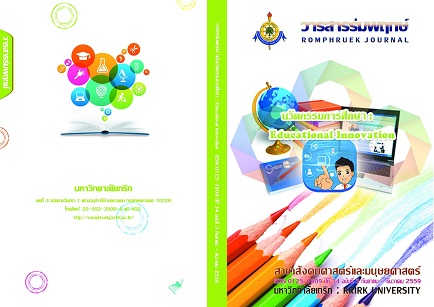เกม : นวัตกรรมเพื่อการศึกษาเชิงสร้างสรรค์ ;Game: Innovation for Creative Education
Main Article Content
Abstract
เกม มีจุดมุ่งหมายเพื่อให้ผู้เล่นสนุกและเพลิดเพลิน แต่เมื่อบริบทโลกเปลี่ยนไป รูปแบบของเกมก็การปรับเปลี่ยนไปเช่นกัน จากเกมเล่นคนเดียวหรือเล่นกับเพื่อน กลายเป็นเกมที่แข่งขันกับระบบต่าง ๆ ที่มนุษย์สร้างขึ้นมีทั้งแบบเล่นคนเดียว เล่นกับเพื่อนไปจนถึงคนแปลกหน้า ความสนุกสนานของเกมทำให้เด็กถูกดึงออกจากครอบครัว สังคมรวมถึงห้องเรียน จนเกิดปัญหาเด็กติดเกมที่ทุกฝ่ายเข้ามาช่วยกันแก้ไข ในอีกมุมมองหนึ่งหากพลิกบทบาทของเกม โดยนำการสอนในรูปแบบเกมมาประยุกต์ใช้โดยพัฒนาเป็นนวัตกรรมทางการศึกษาในรูปแบบของ Game-Based Learning เพื่อจูงใจเด็กกลับสู่ห้องเรียน สร้างบรรยากาศการเรียนที่แปลกใหม่ เด็กเรียนรู้ควบคู่ไปกับความสนุกสนานก็จะช่วยให้เด็กอยากเรียน ซึ่งเป็นวิธีหนึ่งที่ช่วยให้เด็กกลับสู่ห้องเรียน
The goal of a game is for fun and enjoyment of the players. As the world context evolves with time, so are games. The era of single-player games has passed into the world of competitive game environments that can be enjoyed by oneself, with friends, or even complete strangers. The fun of games has pulled children out of their families, societies, and classrooms. These games can eventually result in addiction problems that must be solved by many parties. However, on the flip side, games can be applied in instructions by modifying them into innovative Game-Based Learning methods. This can renew children's interest in learning, creating new learning environments where learning and enjoying coexist, bringing children back into the classroom
Article Details
Every article published in the Romphruek Journal of the Humanities and Social Sciences is the opinion and point of view of the authors. Thery're not the viewpoint of Krirk University or the editored department. Any part or all of the articles for pablication must be clearly cited.
References
ชาญวิทย์ พรนภดล. ติดเกมคืออะไร. (9 กันยายน 2559) สืบค้นจาก http://www.healthygamer.net/faq.
ณัฐญา นาคะสันต์ และ ศุภรางค์ เรืองวานิช. (2559). Augmented Reality : เติมชีวิตให้สื่อสิ่งพิมพ์ทางการศึกษา. วารสารร่มพฤกษ์, 34(2).
ณัฐพล แย้มฉิม. โพล : เสียงจากผู้ปกครอง “วันเปิดเทอม”. (17 กันยายน 2559) สืบค้นจาก
http://suandusitpoll.dusit.ac.th/UPLOAD_FILES/POLL/2558/PS-25581431826128.pdf.
ทอฟฟเลอร์, อัลวิน. (2536). คลื่นลูกที่สาม = The third wave. กรุงเทพฯ : นานมีบุ๊คส์.
พัชราภรณ์ หงษ์สิบสอง นันทา เติมสมบัติถาวร ศิริลักษณ์ นรินทร์รัตน์. (2557). ความต้องการในการแก้ปัญหาการติดเกมออนไลน์และอินเทอร์เน็ตของเยาวชนในเขตเทศบาลตำบลดู่ใต้ จังหวัดน่าน. วารสารวิชาการและวิจัย มรท.พระนคร, ฉบับพิเศษ, 119 - 124.
ราชบัณฑิตยสถาน. (2546). พจนานุกรมฉบับราชบัณฑิตยสถาน พ.ศ.2542. กรุงเทพฯ : นานมีบุคส์พับลิเคชั่นส์.
วรุณา กลกิจโกวินท์ ชัยพร วิศิษฎ์พงศ์อารีย์ พิสาส์น เตชะเกษม ชาญวิทย์ พรนภดล และบุษบา ศุภวัฒน์ธนบดี. (2558). การติดเกมคอมพิวเตอร์ ปัจจัยเสี่ยงและปัจจัยป้องกันของเด็กนักเรียนในเขตดุสิตกรุงเทพมหานคร. วชิรเวชสาร, 59(3), 1-14.
ศูนย์สารสนเทศ สำนักงานปลัดกระทรวงศึกษาธิการ. พระราชบัญญัติการศึกษาแห่งชาติ พ.ศ.2542. (9 กันยายน 2559) สืบค้นจาก http://www.moe.go.th/main2/plan/p-r-b42-01.htm#5.
สถาบันสุขภาพจิตเด็กและวัยรุ่นราชนครินทร์. รายการ LET ME GROW พลิกชีวิตเด็กติดเกม. (12 กันยายน 2559) สืบค้นจาก https://www.facebook.com/letmegrowth/
Alaswad, Z. & Nadolny, L. (2015). Designing for game-based learning: The effective integration of technology to support learning. Journal of Educational Technology Systems, 43(4), 389-402
Bandai Namco. Pac-Man: a visual history. (December 21, 2016) Retrieved from http://pacman.com/en/pac-man-history.
Deniz Eseryel, Victor Law, Dirk Ifenthaler, Xun Ge and Raymond Miller. (2014). An Investigation of the Interrelationships between Motivation, Engagement, and Complex Problem Solving in Game-based Learning. Educational Technology & Society, 17(1),
–53.
Exceed7 Experiments. (December 21, 2016) Retrieved from http://exceed7.com/
Extend Interactive. (December 21, 2016) Retrieved from http://x10interactive.com/.
Ifenthaler, Dirk, Eseryel, Deniz and Ge, Xun. (2012). Assessment in Game-Based Learning : Foundations, Innovations, and Perspectives. New York : Springer.
Chien-Hung Lai ,Tsung -Po Lee, Bin-Shyan Jong and Yen- Teh Hsia. (2014). A Research on Applying Game-Based Learning to Enhance the Participation of Student. (September 16, 2016) Retrieved from
http://link.springer.com/chapter10.1007%2F978-94-007-5076-0_36.
Jan L. Plass, Bruce D. Homer, Charles K. Kinzer. (2015). Foundations of Game-Based Learning. EDUCATIONAL PSYCHOLOGIST, 50(4), 258–283.
Lebling, P. D., Blank, M. S., & Anderson, T. A. (1979). Zork : A Computerized Fantasy Simulation Game. MIT Laboratory for Computer Science, SPECIAL FEATURE, 51-59.
MAD Virtual Reality Studio. ARAYA on Steam. (December 21, 2016) Retrieved from http://store.steampowered.com/ app/466740/.
Merriam-Webster. game. (August 28, 2016) Retrieved from
http://www.merriam-webster.com/dictionary/game.
Niantic. Ingress Prior Events. Ingress. (December 21, 2016) Retrieved from https://www.ingress.com/events/archives.html.
Nintendo. Company History. (December 21, 2016). Retrieved from http://www.nintendo.com/corp/history.jsp.
Pho, A. & Dinscore, A. Game-Based Learning. (September 13, 2016) Retrieved from http://www.ala.org/acrl/sites/ala.org.acrl/files/content/aboutacrl/directoryofleadershi p/sections/is/iswebsite/projpubs/tipsandtrends/spring2015.pdf.
Rollings, A. and Morris, D. (1999). Game Architecture and Design. Scottdale, AZ : Coriolis Group Books.
Sonders, M. Pokémon GO demographics : The evolving player mix of a smash-hit game. Survey Monkey Intelligence blog (December 7, 2016) Retrieved from
https://www.surveymonkey.com/business/intelligence/ pokemon-go-demographics/.
Taito Corporation. Corporate Profile. (December 21, 2016) Retrieved from https://www.taito.com/corporate/history.
Teed, R. Game-Based Learning. (September 15,2016) Retrieved from http://serc.carleton.edu/introgeo/games/whatis.html.
Tosawat. LevelUp! Studio. (December 21, 2016) Retrieved from http://www.levelup.in.th/.

